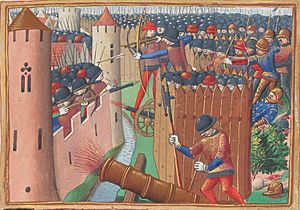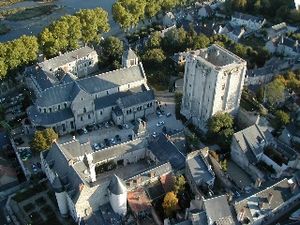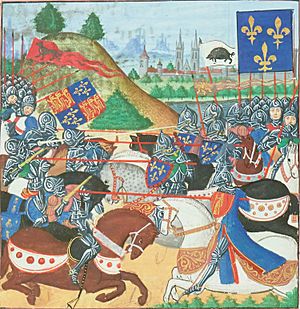Loire Campaign (1429) facts for kids
Quick facts for kids Loire Campaign |
|||||||
|---|---|---|---|---|---|---|---|
| Part of the Hundred Years' War (1415–53 phase) | |||||||
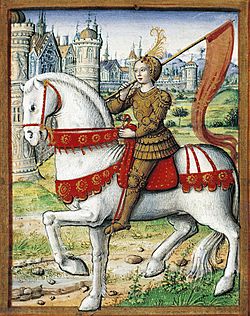 Joan of Arc, the leader of the campaign. |
|||||||
|
|||||||
| Belligerents | |||||||
| Commanders and leaders | |||||||
| Strength | |||||||
| about 19,900 troops | about 11,200 troops | ||||||
| Casualties and losses | |||||||
| over 2,500 | about 9,000 | ||||||
The Loire Campaign was a very important series of battles led by the famous French hero, Joan of Arc. It happened during the Hundred Years' War, a long conflict between France and England. This campaign aimed to clear the Loire Valley in France of all English and Burgundian soldiers. The English and Burgundians were allies against the French. Joan of Arc's leadership helped the French win a great victory.
Contents
The Campaign Begins
The English army, led by John, Duke of Bedford, ordered their general, John, Lord Talbot, to attack the city of Orléans. His helpers were the Earl of Suffolk and the Earl of Salisbury. The English were close to winning the siege.
However, Joan of Arc arrived and led many counterattacks. Joan, with the help of other French leaders like Gilles de Rais, Jean de Dunois, and Jean de Brosse, attacked the English positions around Orléans. The English could not stop these attacks. Lord Talbot had to pull his troops back and end the siege. This was a big win for the French and a sign of Joan's growing power.
The Battle of Jargeau
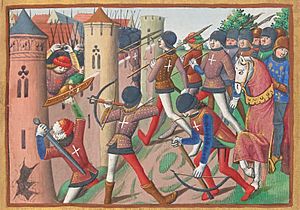
After Orléans, Joan and John II, Duke of Alençon marched to capture the town of Jargeau from the Earl of Suffolk. The English had about 700 soldiers, while the French had 1,200. The battle started with a French attack on the areas just outside the town walls.
The English defenders left the city walls to fight, and the French soldiers fell back a little. Joan of Arc used her special flag to encourage the French to fight harder. The English then went back inside the city walls. The French army stayed in the outer areas for the night.
The next morning, Joan of Arc asked the English defenders to give up. They refused. So, the French began a heavy attack using their artillery. This meant they fired primitive cannons and other siege engines (like giant slingshots) at the town. One of the town's towers fell down.
The Earl of Suffolk tried to surrender to a minor French captain, La Hire. This was against the usual rules of war and made the French commanders angry. Joan of Arc then led an attack on the town walls. A stone hit her helmet, but it split in two, and she was unharmed as she climbed a ladder. The English lost many soldiers, about 300 to 400 out of 700. Suffolk was captured. The French had about 1,200 troops and lost very few. After this victory, Joan moved her army to Meung-sur-Loire.
The Battle of Meung-sur-Loire
Next, Joan began her attacks on Meung-sur-Loire. The English defenses there had three parts. There was the walled town itself, a fort at the bridge, and a large walled castle just outside the town. The castle was where the English commanders, Lord Talbot and Lord Scales, had their headquarters.
Joan of Arc and Duke John II of Alençon led a strong French force. Other important captains with them were Jean d'Orléans, Gilles de Rais, Jean Poton de Xaintrailles, and La Hire. Some records say the French had 6,000 to 7,000 soldiers, but this might include people who weren't fighting. The English army was smaller than the French.
Instead of attacking the town or the castle, the French went straight for the fort at the bridge. They captured it in just one day and left some soldiers there to guard it. This made it harder for the English to move their troops south of the Loire River.
The Battle of Beaugency
Joan continued her campaign by attacking Beaugency. Joan of Arc and Duke John II of Alençon again led the French forces. Their captains included Jean d'Orléans, Gilles de Rais, Jean Poton de Xaintrailles, and La Hire. John Talbot was in charge of the English defense.
Breaking from the usual way of fighting sieges, the French army captured the bridge at Meung-sur-Loire on June 15. Then, instead of attacking Meung-sur-Loire itself, they attacked Beaugency the very next day. At Beaugency, the main English stronghold was inside the city walls. This castle still stands today and looks like a strong, rectangular fortress.
During the first day of fighting, the English left the town and went back into the castle. The French then fired their artillery at the castle. That evening, de Richemont and his soldiers arrived to help the French.
The French leaders heard that an English relief force was coming from Paris. This force was led by Sir John Fastolf. So, d'Alençon quickly talked with the English to arrange their surrender. He allowed them to leave Beaugency safely. The very next day, on June 18, the Battle of Patay took place in an open field.
The Battle of Patay
An English army, sent to help, left Paris after the defeat at Orléans. This army was led by Sir John Fastolf. The French had moved very quickly. They captured three bridges and accepted the English surrender at Beaugency just the day before Fastolf's army arrived. The French believed they could not beat a fully prepared English army in an open battle. So, they searched the area hoping to find the English when they were not ready.
The English army met up with the remaining defenders at Meung-sur-Loire. The French had only taken the bridge there, not the castle or the town. Soldiers who had retreated from Beaugency also joined them. The English were usually very good at fighting in open battles. They set up their positions near a small village called Patay. Fastolf, John Talbot, and Sir Thomas de Scales led the English.
The English longbowmen usually used a special defense tactic. They would stick pointed stakes into the ground in front of their positions. These stakes stopped cavalry charges (horse attacks). They also slowed down infantry (foot soldiers) long enough for the longbows to cause a lot of damage. However, the English archers accidentally showed their position to French scouts. This happened when a deer wandered into a nearby field, and the archers shouted a hunting cry.
When the French heard where the English were, about 1,500 French cavalry soldiers attacked. These were heavily armed and armored horsemen led by captains La Hire and Jean Poton de Xaintrailles. The battle quickly turned into a complete defeat for the English. Every Englishman on a horse ran away. The foot soldiers, mostly longbowmen, were killed in large numbers. Longbowmen were not meant to fight armored knights without support, especially not from unprepared positions. They were massacred. For once, the French tactic of a large cavalry charge from the front had worked perfectly.
Captain Jean Dagneau captured the famous English general, John Talbot. Because of this brave act, King Charles VII of France made Dagneau a nobleman in March 1438. This is how the Dagneau de Richecour family name began.
Aftermath
Joan of Arc had led the French to a great victory in all these battles. The Loire Campaign successfully drove the English out of the Loire river region. Sir John Fastolf's army was completely defeated and forced to retreat back to Paris. This campaign was a huge step towards French victory in the Hundred Years' War, and many gave credit to Joan of Arc for her amazing leadership.


